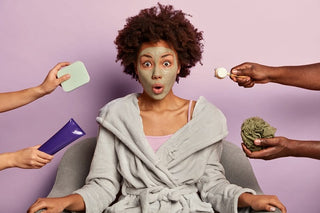In every country around the world, public health organisations make decisions about which ingredients should be allowed in our food, beauty, and medicinal products, and which are to be prohibited from use. However, if you look at the list of banned ingredients in the United States versus similar lists from European countries, the comparison may shock you.
In Europe, the EU Cosmetics Regulation has banned over 1300 deemed dangerous substances for use in cosmetic products. On the other side of the pond, the United States of America’s FDA (Food and Drug Administration) has banned only 11 cosmetic ingredients. The difference is staggering.
What does this mean for US consumers?
American consumers must be more vigilant when choosing and purchasing non toxic skincare products. There are many ingredients found in US products that have been proven to be harmful. Pay close attention to ingredient lists, and consider purchasing products made outside of the US. For example, Swiss skincare brands like Swiss Toniq offer natural, plant based skincare options free from dangerous chemicals and free from all synthetic substances. They are so safe you could literally eat them.
Let’s look at some common skincare ingredients found in American products that are banned elsewhere.
1. Formaldehyde
You might remember from your high school science days that formaldehyde is used to preserve dead tissue. Sounds like a great ingredient to apply to your face, right? Unfortunately, formaldehyde is a preservative in many American skincare and cosmetics products, including nail polish, hair gel, eyelash glue, baby soap, and shampoo.
Formaldehyde works well to preserve packaged beauty products and to prevent microbe growth, but it is also a highly toxic substance for other living beings. While the European Union restricted formaldehyde usage in cosmetics and skincare products, American companies continue to use it. Exposure to formaldehyde can cause breathing problems, coughing, and irritation to the skin. There is also research to prove it is linked to some cancers.
2. Parabens
Parabens are another common cosmetic preservative used to prevent mold and bacteria growth. Parabens can also cause allergies, damage to the reproductive organs, and breast cancer. These substances have been found to disrupt the body’s hormones, causing all sorts of health issues.
The European Union has banned parabens in cosmetic and beauty products, but despite pressure from scientists and consumers, the US still allows their usage. You can find parabens on many ingredients lists, under the names methylparaben, polyparaben, isobutyl paraben, butylparaben, and propylparaben. Parabens in the United States are used in toothpaste, deodorant, sunscreen, shaving gel, facial cleansers, moisturisers, shampoos, and conditioners.
3. Coal Tar and Carbon Black
Coal tar is a byproduct of burning coal for fuel. It is a known carcinogen banned in Europe that causes skin tumours, cancer, and neurological damage. In America, coal tar treats dandruff, eczema, and psoriasis. Be sure to avoid coal tar in hair dyes and anti-dandruff shampoos whenever possible.
The American FDA actually bans carbon black for causing lung issues and increasing the risk of some cancers, but you can still find it in skincare and cosmetic products. Double-check the ingredient lists on eyelash glues, eyeliners, and mascaras for carbon black, furnace black, D&C black no. 2, lamp black, thermal black, and channel black.
4. Phthalates
Phthalates have been linked to hormone disruption, reproductive issues, and cancer and are banned in the EU. You will often find them in the US on ingredient lists under the word “fragrance.” Phthalates are used in nail polishes, lotions, cleansers, hair sprays, perfumes, and shampoos. They are also known to cause damage to internal organs, including the lungs, reproductive organs, liver, and kidneys.
5. Petroleum Jelly
Another ingredient you should try to avoid in US skincare products is petroleum jelly. It is often used in lotions as a moisturiser. While petroleum jelly is not always harmful, if refined incorrectly, it can create polycyclic aromatic hydrocarbons. These PAHs are toxic chemicals in crude oil, gasoline, and coal.
6. Lead
Yes, lead. While lead in household paint was banned in America in 1978, it is still used in small amounts in US-produced lipsticks. Lead is a well-known neurotoxin and is linked to fertility issues in both men and women. While the EU prohibits using lead as even trace amounts can cause health issues, the American FDA has decided that lead in lipstick is acceptable. You can also find lead on the ingredient lists of some American hair dye products.
Non-Toxic Alternatives
All cosmetic and personal care companies in Europe and the US must list product ingredients. While checking every ingredient list on American-made products can be daunting and time-consuming, it is the only way to ensure that what you put on your skin is safe and non-toxic.
An alternative to this is to stick with European-made skincare products. Swiss skin care goes even further than other European countries if you are seeking the cleanest and best, with limits on substance concentrations and other usage restrictions. The strict skincare regulations in Switzerland ensure that products from companies including Swiss Toniq are all-natural, organic, and free from any harmful chemicals.










